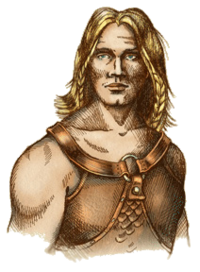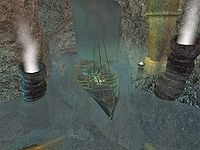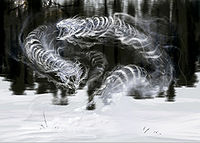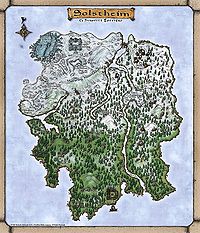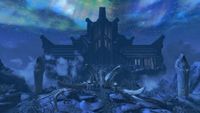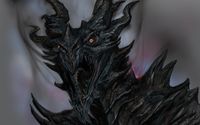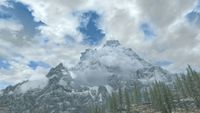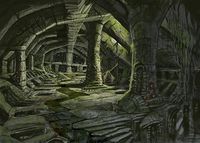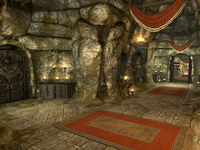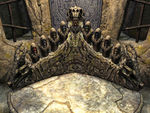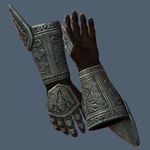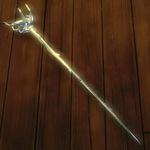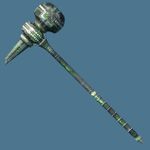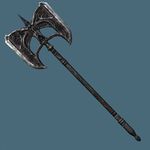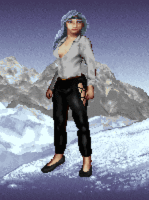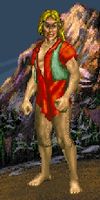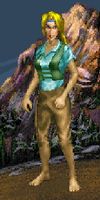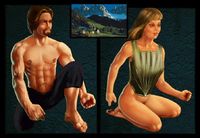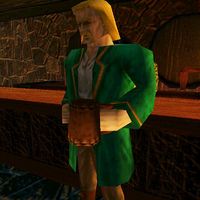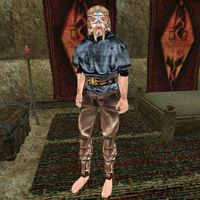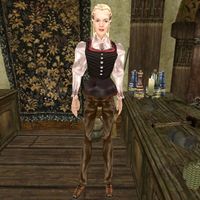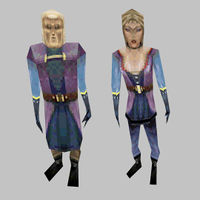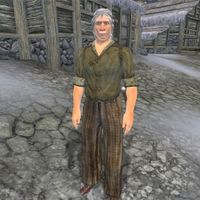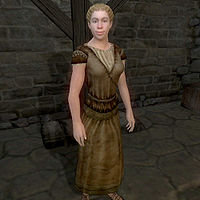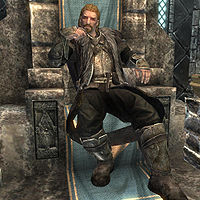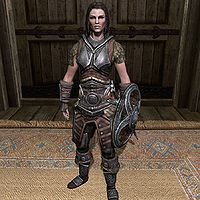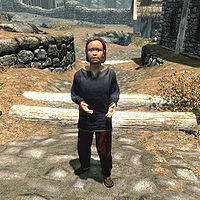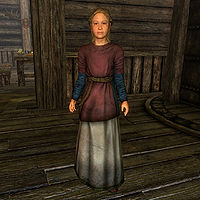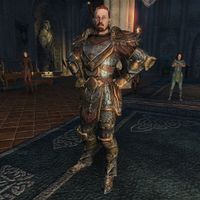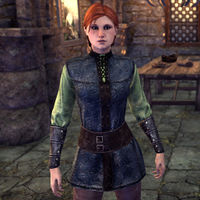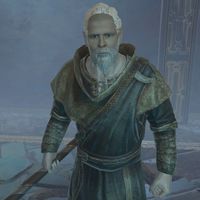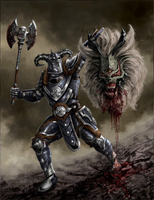Lore:Nord
Nords (called Bron singular in the Language of Dragons[1]:1096) are the Children of the Sky,[2] a race of tall and fair-haired humans from Skyrim who are known for their incredible resistance to cold and magical frost. They are fierce, strong and enthusiastic warriors, and many become renowned warriors, soldiers and mercenaries all over Tamriel.[3][4] Eager to augment their martial skills beyond the traditional methods of Skyrim, they excel in all manner of warfare, and are known as a militant people by their neighbors.[5][6] Nords were known for a time for their nautical prowess when they migrated from Atmora.[6] Seafaring merchants or smugglers are not unheard of, as was the case with Tobias.
When the descendants of the Atmorans transitioned into calling themselves Nords is blurred. The inhabitants of Skyrim during the Dragon War were variously labeled Nords[7] and Atmorans.[8] The truth may lie somewhere in-between; while the two are considered distinct races,[9] the men living in the transition period between the terms' respective usage have been considered 'proto-Nords'.[10][11][12] High King Harald started a trend when he relinquished all holdings in distant and lost Atmora and united the disparate Nordic people to formally create the Kingdom of Skyrim.[5] However, according to Great Harbingers, these people didn't consider themselves Nords until sometime after the Redguards arrived to Tamriel.[13]
History[edit]
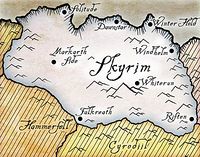
Although Nords intermingled with other races over the years, it is primarily to Atmora, the northernmost known place on Nirn, that they trace their lineage.[5][10] Atmora is likely a human corruption of "Altmora", a name found in old Elvish records which means "Elder Wood".[14] Legends say that Atmora was once very green and prosperous, until "the freezing" turned it into an inhospitable wasteland plagued by civil war, causing its people to migrate to Tamriel in waves throughout the Merethic and First eras.[15] During this migration, the chieftain Ysgramor rallied people from all sides who desired to live in peace and set sail south, eventually arriving at Hsaarik Head, at the extreme northern tip of Skyrim's Broken Cape.[5] They named the new land "Mereth" in tribute to the Aldmeri Elves who had already settled most of the continent. Contrary to many stories, which apparently credit Ysgramor with being the leader of the first group of human settlers,[16][17] he and his colonists were the latest in a long line of emigrants from Atmora to Skyrim, and many had already migrated to other places around Tamriel.[18][10]
The Return[edit]
Elves and men lived in relative peace and prosperity for a great deal of time, but racial tensions grew along with the human population, and eventually violence erupted. It's unclear how it started, but the Elves razed the Nordic capital city of Saarthal, killing the defenders and everyone unable to flee, in a slaughter now known as the Night of Tears.[5][16][19][20] According to legend, the only humans to survive were Ysgramor and his two sons, who fled back to Atmora, where they gathered the famous Five Hundred Companions and sailed back to expediently slaughter any Elves they came across, founding new cities as they went and clearing the way for new settlers.[16][5][13][21][15] During this time, the Nords also frequently waged war with the various Giant clans of Skyrim and Ysgramor purportedly slaughtered hundreds of Giants himself.[22][23] Despite these early conflicts, the presence of Giants remained throughout the province in the eras that followed, although both races largely kept to themselves.
The Five Hundred's great achievements and acts of heroism cemented them and their leader Ysgramor as role models in Nordic culture.[15] Their legacy is purportedly carried on by the Companions, a group of nonpartisan mercenaries who are renowned as impartial arbiters on matters of honor.[13][15] Ysgramor's descendant High King Harald, who is credited with first uniting the province under its customary borders drove the last of the Elves out of the province in 1E 143.[5] Despite heavy resistance, Elves were also driven from Solstheim, a small island northeast of Skyrim, which would be predominantly inhabited by Nords for thousands of years to come.[24]
The Dragon War[edit]
Dragons were revered as part of the Nordic religion.[25] Dragon priests, on par with kings in terms of the power they wielded, acted as intermediaries between the people and the serpentine "god-kings", whose name could not even be uttered by the common folk.[25] Temples were built to honor and appease the dragons, many of which survive today as ancient ruins haunted by Draugr and undead dragon priests.[25][26] The dragon priests in Tamriel became more tyrannical and the populace eventually rebelled some time in the Merethic Era, leading to the legendary Dragon War.[25] Some dragons turned against their own kind and taught the Nords powerful magic that allowed them to turn the tide of the war in their favor.[25] After a long and bloody campaign, the rule of the dragons was ended, and the remaining wyrms fled to remote areas.[25] The Dragon Cult survived for a time, but was marginalized and eventually died out.[25] The last Dragon Cult Stronghold was found and besieged in 1E 140.[27] Not long after, worship of animal gods was replaced by the then-Eight Divines in mainstream Nord culture.[28] Other traditional Nordic beliefs, known as the Old Ways, continued on, and remained prevalent among Nords even after the introduction of the Divines.[29][30]
The Skyrim Conquests[edit]
In 1E 241, King Vrage the Gifted (Harald's son) began the aggressive expansion now known as the Skyrim Conquests, which would culminate in the First Empire of the Nords.[5][10][31] Within a span of fifty years, the descendants of Ysgramor ruled all of northern Tamriel, including most of present-day High Rock and the whole of Morrowind.[5][10] Some Nord leaders wanted to turn south to Cyrodiil, but the Jerall Mountains proved to be too big a barrier, and northern Cyrodiil too poor a prize.[4] However the Nordic Empire allied with Alessia's slave rebellion, and aided in overturning the Ayleid Empire, and in return were given territory in the Nibenay Valley.
Over the next few centuries, Skyrim expanded and contracted as battles were won and lost.[18] The Conquests, and the Empire, came to an end in 1E 369 with the death of King Borgas, the last of the Ysgramor line, during the Wild Hunt.[5][4] When the ruling council or Moot was unable to choose Jarl Hanse of Winterhold (considered the obvious choice by Imperial scholars), as the new High King, the ensuing civil war tore the Empire apart.[5] The war concluded in 1E 420 with the Pact of Chieftains, but the Empire lost its holdings in High Rock and Morrowind, and Skyrim was divided into independent kingdoms.[5] The Nords were overthrown by a combined alliance of Chimer and Dwemer who formed the First Council. The failure of the Nord Tongues in Morrowind prompted Jurgen Windcaller to begin a seven-year meditation to understand the failure, leading to the foundation of the Way of the Voice.[5][32]
The Nords would make an alliance with Orcs to try to reconquer Morrowind around 1E 700, partaking in the War of the First Council, but it is unclear whether they allied with the Chimer, the Dwemer, or acted as a third party. Nevertheless the Nords failed to increase their territory, and the Tribunal would protect Morrowind from invasion for thousands of years to come.[33][34][6][35][36]
The Second Empire and the Interregnum[edit]
Late in the First Era, an invasion from Akavir cut through Skyrim.[37] Even though Nords don't "meet invasions with pitchers of mead", they were unable to stop the mighty Akaviri Dragonguard, and it took the united armies of Cyrodiil to stop their advance at the Battle of Pale Pass.[37] The Nords were understandably impressed, and for the first time, the whole of Skyrim pledged allegiance to one man: Reman Cyrodiil, one of the first Dragonborn recorded in history and the founder of the Second Empire of Man.[37] The Nords would generally support the Empire, even under the Potentates, for hundreds of years to come.
Only a year after the assassination of the last Potentate in 430 and the official dissolution of the 2nd Empire, High King Logrolf was assassinated and Skyrim was partitioned between the east and west following a succession dispute. Western Skyrim would consist of Haafingar, Hjaalmarch, Falkreath, Whiterun and a portion of the Reach named Karthal, and Eastern Skryim was composed of Winterhold, Eastmarch, The Pale, and the Rift. Various factions vyed for control of Cyrodiil and its claim of Empire, most climactically in the Three Banners War. While Western Skyrim maintained neutrality, Eastern Skyrim would help form the Ebonheart Pact. Eastern Skyrim was ravaged by the second Akaviri invasion in 2E 572, with Windhelm sacked, but the Nords pursued the invading Akaviri into Morrowind, where they were joined by the defending Dunmer. The Akaviri forces were successfully wiped out thanks to the unexpected arrival of Argonian armies from Black Marsh's northern tribes. The victors of the battle formed the Ebonheart Pact (though House Telvannis abstained in protest with the precondition of ending the enslavement of Argonians) with the aim to maintain their mutual independence and defense, and would war against the Greater Daggerfall Covenant and 1st Aldmeri Dominion for control of Cyrodiil. However the Ebonheart Pact would ultimately dissolve at some point during the Second Era, as would their main competitors in the Alliance War.
The chaos of the Interregnum brought the Nords an opportunity for glorious battle against their neighbors. Together with the Bretons of High Rock, they once again looked south, to Cyrodiil, for room to expand.[38] Despite some initial success, they did not count on Tiber Septim. According to Nordic Tradition, Tiber Septim was born in Atmora under the name Hjalti Early-Beard (though Bretons claim he was born instead on the island of Alcaire). He served as General to Cuhlecain, king of Falkreath and the Colovian Estates. Hjalti Early-Beard used the power of the Thu'um to shout down the walls at Old Hroldan, allowing Culhecain to conquer the Reach. This led the Greybeards to summon him to High Hrothgar where they named him Talos.
The Nords were suspicious of the rising power to the south, and allied with their Breton neighbors to subdue them, leading to the Battle of Sancre Tor. Despite being seemingly impregnable, a spy within the Nordic ranks allowed Tiber Septim to take the ancient city, and upon demonstrating his Thu'um the Nords reportedly bent their knee and pledged fealty to Tiber Septim (reportedly the Nords had already grown suspicious of their Breton allies). This marks the beginning of the integration of Skyrim in what would soon become the Third Empire.
Under the Third Empire[edit]
Skyrim was absorbed comparatively peacefully into the empire of Tiber Septim, the Battle of Sancre Tor around 2E 852 and other clashes notwithstanding.[38][39] Many Nords found employment in the Imperial Legion, as Talos generally nurtured relations with the north.[38] In the centuries after the Empire's founding, Skyrim was drawn into several major conflicts. One of these was the War of the Red Diamond wherein Skyrim supported Queen Potema against the Empire.[40] The civil war nearly tore the Empire apart and it would take seventeen long years before Potema was finally defeated and peace was restored.[40] However, a strong underground movement called the Hörme, believing that Potema and her deposed son were the last of Tiber Septim's true blood, continued to work against Imperial interests in Skyrim.[18]
Close to the end of the Third Era, the kingdoms of Skyrim instigated several wars to expand their territory. The War of the Bend'r-Mahk during the Imperial Simulacrum increased Nordic holdings considerably, swallowing up many miles of territory traditionally belonging to eastern High Rock and Hammerfell, and they have their eyes on Morrowind, which is no longer protected by the Tribunal.[18]
The Fourth Era[edit]
The Fourth Era brought significant changes for Nords. Late in the Third Era and in the beginning years of the Fourth Era, Solstheim became overrun by Dunmer refugees from Morrowind, which had been devastated by natural disasters and then invaded by the Argonians of Black Marsh who had already conquered much of Morrowind.[41] The Nords of Solstheim wanted to win independence from the Empire, and planned to destroy Fort Frostmoth.[42] Many Dunmer also fled west on the mainland, establishing a strong presence in cities in eastern Skyrim.[43] Following the sacking of Nova Orsinium, many Orc refugees were escorted into Skyrim by the Imperial Legion.[44] Many Orcs choose to segregate their society and live in Orc Strongholds scattered throughout the wilderness, but some others have, like the Dunmer, chosen to live in the "civilized" settlements of Skyrim. Despite some trepidation at these newcomers, the Nords remained relatively peaceful and prosperous, with some exceptions,[45][46][47] in the tumultuous aftermath of the Oblivion Crisis.[41][48] However, their peace would not last.
Around 4E 200, a little over twenty years after the Great War ended, the High King of Skyrim was killed. Resentments created by the White-Gold Concordat which ended the Great War, launched Skyrim into the bloody Stormcloak Rebellion, named after the leader of the rebels, Jarl Ulfric Stormcloak.[48][49][50] Even more disturbing was the return of Alduin, the ancient enemy from the Dragon War who had led the massacres against them, which Nordic religion had long held would herald the end of the world.[49][51]
Society[edit]
There are two things most Nords love: music and mead.[51] Most Nords wear animal skins or cotton clothing.[52] They are generally tolerant of outsiders to Skyrim, though often do not make them feel welcome.[13][43][53] In particular, Nords often still hold a bitter resentment towards elves. The Reach, one of the nine Holds of Skyrim, has only a slight Nord majority, and cities in the east have become heavily influenced by the Dunmer.[5][43] The northern and eastern holds - Winterhold, Eastmarch, The Rift, and The Pale—are known collectively as the Old Holds, where the influence of old Nordic traditions is still relatively strong and outsiders are rare.[5] The young men there go out for weeks into the high peaks in the dead of winter, hunting the ice wraiths that give them claim to full status as citizens.[5] The Reach and the Rift both have long histories of lawlessness, and are generally associated with criminal activity.[54][55][39][47]
Nords tend to be superstitious, and their folklore reflects this.[55][56][57][58] Nordic names, often chosen based on omens, are given in a special ceremony when the child is young.[56] Any unexplained misfortune is often blamed on the Falmer, or Snow Elves.[5] The Falmer, long believed to be extinct after the vengeful Nordic invasion into their lands, caused by the aggressive Falmer response to the new Atmoran inhabitants, were actually driven deep underground, where they became feral and purportedly seek to kill all those who dwell above them,[59] so it's possible there's truth in some of these claims.
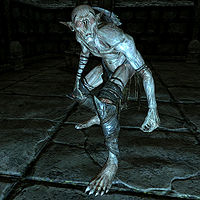
Nords practice wergild, a traditional rite of retribution. When a life is taken, a life must be accounted for. Items of high value can serve as fitting payment.[60][61][62]
Architecture[edit]
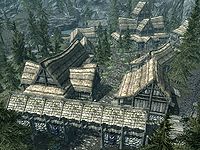
Nords are known as masters of wood and timber construction.[5] Besides the cities of Skyrim, their architectural style is reflected in Bruma, situated in northern Cyrodiil.[63] Nord buildings are built partly underground to conserve heat, and are made with stones, with wood used only for support, and roofs of straw above the wood. These houses are essential to keep in heat in the freezing climate. Similar designs are also seen in Solstheim.
Nordic buildings are known for being able to withstand the harshest elements for thousands of years.[5] Old Fort, one of the royal bastions constructed by the First Empire to guard its southern frontier, is a fine example: "towering walls of huge, irregular porphyry blocks fit together without seam or mortar" have stood since the First Era.[5]
Holidays[edit]
- Feast of Dibella
- It is common to display a silver, moth-shaped mirror for the annual Feast of Dibella celebration.[64]
- Feast of the Dead
- The Nords of Windhelm celebrate the Feast of the Dead on the 13th of Sun's Dawn to honor the Five Hundred Companions and their ancient accomplishments.[28] The names of each of the companions are recited every year.[5]
- Konunleikar
- It is traditionally the tenth anniversary of the High King's coronation. It consists of drinking and games, such as the Footrace of the Nine Holds.[65][66]
- Wintertide Festival
- A holiday celebrated every year in the winter. Wealthy Nords have a serious tradition of saving snow during this time and preserving them in jars.[67]
Food[edit]
- Main Article: Nord Cuisine
Nord cuisine reflects the harsh climate and rugged landscape that has shaped their warrior culture. Farming is difficult, but wild game supplies a good deal of their nutrition. These meats are preserved through smoking, drying, pickling, or salting. Fish are also a prominent feature in Nord cooking, such as the salmon endemic to the White River. The Nords are reputed for their great, warm, hearty feasts. Large roasts of mammoth, horker, and assorted game meats are cooked over a spit in the center of the hall, while rustic desserts made with juniper or snowberries are baked in cob ovens. The fruits available in Skyrim's scattered bushes have also made their way into the mead that is much-loved by this rugged race, which has developed a reputation abroad for being sweet and strong.
Language[edit]
The modern Nordic language comes from the Ancient Nordic tongue, which in turn copies from the Dragon Language. The semblance comes from the alphabet, which looks like claw marks and scratches.[68] Nords can still be found using phrases from the Dragons such as "Evgir Unslaad," which means "Season Unending,"[69] or "Thu'um," which means Shout.[5] The Nordic god, Jhunal is considered the father of languages.[70]
Religion[edit]
The Nords are considered to be a devout people with grim religious beliefs. Among other things, they have long believed that Alduin, the World-Eater, would eventually return and bring about the end of the world.[70] As dark as their belief systems are viewed to be, all Nordic traditions extend one bright, shining hope for Nords: Sovngarde, the Hall of Valor, where Nords who have proven their mettle in battle or died valiantly are welcome to experience euphoric bliss and camaraderie, free from time and boredom.[75][76] Some stories claim the place was built by, and still inhabited by, the elusive Shor.[75] It is little surprise that cowardice is the worst trait a Nord can exhibit, for "a Nord is judged not by the manner in which he lived, but the manner in which he died".[76] Nords cross the whalebone bridge to reach Sovngarde, and flying whales are a cultural metaphor for the transition from Nirn to Aetherius.[77]
The Old Ways[edit]
Ysgramor and the Atmorans brought with them the worship of animal gods: the hawk, wolf, snake, moth, owl, whale, bear, fox, and most importantly the dragon.[25] Over time, as Nord beliefs evolved, the traditional Nordic Pantheon of Divines emerged as personifications of natural forces and ideas.[70] Many scholars believe that the Nordic Pantheon is the same as the orthodox pantheon, merely with different names (there are certainly many parallels), and many Nords who have adopted the Divines evidently have this understanding.
The isolated Nordic tribe in Solstheim, the Skaal, carry on a tradition very similar to the old tradition of animal worship. The Skaal venerate all of nature, believing that certain parts of their environment, such as the winds, the trees and the sun, were given to them by the All-Maker, a benevolent, unknowable creator deity. Wolves and bears are especially sacred to the small tribe. All aspects of nature must constantly be in harmony, for this is what gives the Skaal their shamanic powers. The Skaal also tell tales of the Adversary, the enemy of mankind, and his lieutenant, the Greedy Man. In this regard, the faith of the Skaal is nearly the opposite of the pantheon of their kin in Skyrim.[78] Although the Skaal do not worship them, they also acknowledge the existence of the Daedric Princes.[79]
The Nordic Pantheon[edit]
Like most modern Tamrielic races, Nordic religion is focused on the Aedra and their old ally, Lorkhan, which they call Shor.[80] However, the Nord's Sky Goddess Kyne is notably more assertive and warlike than the nature-loving Kynareth.[70] Although Mara is present in her role as a mother goddess, she is thought of as a mere handmaiden to Kyne, the actual mother of the Nords and the widow to Shor.[2][70] She is also credited with sending her son Morihaus (and perhaps Pelinal) to the aid of the Cyro-Nordic slaves in their uprising against the Ayleids around 1E 242.[80] Shortly after, the Nordic pantheon of gods would be fused with the Aldmeri pantheon by Alessia into the Eight Divines (although this new belief system would be bucked occasionally).[80][36] Interestingly, certain Daedra, notably Hermaeus Mora, are present in Nordic mythos.
- Kyne, the Hawk
- Goddess of the storm, widow of Shor, and head of the Nordic pantheon. She gave the men the power of the storm voice.
- Mara, the She-Wolf
- Mother goddess and handmaiden of Kyne.
- Jhunal, the Owl
- God of runes and hermetic orders.
- Shor, the Fox
- Dead god and ruler over Sovngarde.
- Stuhn, the Whale
- Stuhn is the god of ransom, fraternity and justice. He taught the Nords the benefit of taking prisoners of war, and is represented by the whale.
- Dibella, the Moth
- Goddess of beauty and inspiration of artists.[81]
- Tsun, the Bear
- God of trials against adversity. He died defending Shor and became the guardian of the bridge to the Hall of Valor.
- Orkey, the Snake
- Orkey, Herma-Mora and Mauloch are the Testing Gods. They are not worshiped; rather, the Nords guard against them to protect the hearth.[82]
The former chief of the Nordic pantheon of Skyrim is Shor. He was the king of the gods and a champion of men in their struggles against the Elves,[70] until being treacherously slain by elven devils, and consigned to serve as god of the underworld. He may still have an impact on the mortal world in the form of the Shezarrine. Shor was left out of the Eight Divines, but is still represented in a way acceptable to some Nords as "the spirit behind all human undertaking" in the Cyrodilic pantheon.[80][36] Shor, and Shezarr, are suspected to be the same entity as Lorkhan.[70]
The traditional Nordic pantheon has had a very muddled history with Akatosh, the Dragon God of Time, and misconceptions abound. The totem animals of the Old Ways included the dragon, whom scholars correlate with the worship of Akatosh, but the veneration of dragons understandably dwindled among Nords after the Dragon War.[25] The Nords of the First Era thus only came to know Akatosh as Auri-El, the Elven deity, whom they demonized.[80] Nevertheless, Akatosh was reintroduced in Alessia's compromised pantheon. Many scholars over the years, most of whom were foreigners unfamiliar with the nuances of Nordic history, have mistakenly assumed that Alduin was merely the Nordic name for Akatosh.[70][83][84] Due to mistrust of Nordic education and the integrity of their oral traditions, even well-informed scholars dismissed the dichotomy despite the fact that Akatosh's benevolent nature bore no resemblance to Alduin and that Nords who accepted Akatosh as a deity maintained that he was distinct from Alduin.[70][83][84]
The Thu'um and the Dragonborn[edit]
The spiritual relationship between the Nords and breath is crucial to understanding Nordic beliefs and motivations. They believe Kyne breathed life into them at the Throat of the World, the highest mountain in Skyrim.[2][5] Another creation myth involves the Ehlnofey, wandering progenitors of the Mythic Era, some of whom were displaced to Atmora during the Ehlnofey wars of the Dawn Era and became the Nords.[17] The Nords themselves do not believe in any single creation myth, as they hate to waste time thinking over it, and for many Nords the closest allegory they have for one is simply the oldest story they know.[UOL 1] The two stories are not necessarily in conflict, as they both seem to suggest that Nordic ancestors emerged in Skyrim, flourished in Atmora, then returned. Regardless, the Nords believe that their breath and voice are their vital essence, and that by uttering shouts in the tongue of the dragons, they can channel their essence to perform incredible feats.
Nords have been able to use the thu'um, a magical shout capable of extraordinary power, as a nearly unstoppable weapon against their adversaries as far back as the late Mythic Era.[25][85] They view it as a gift from Kyne, and those with the talent to wield it are called "Tongues".[70][2] The ancient Greybeards, masters of the thu'um, still sit atop the 7000 steps leading to the settlement of High Hrothgar, near the summit of the Throat of the World, where they practice the Way of the Voice.[5] Their leader, Jurgen Windcaller, brought about a ban on the use of the thu'um outside of times of "True Need".[5][32] Tiber Septim established the Imperial College of the Voice in Markarth in an attempt to turn the Way of the Voice to warfare.[5] While some Tongues like Ulfric Stormcloak have proved willing to use the thu'um for violence, the use of the thu'um in warfare has remained extremely rare among Nords. It is false to assume, however, that the Way of the Voice demands pacifism: while the Greybeards don't take up arms directly, they occasionally speak, and thereby set titanic events in motion. They have spoken together on only two known occasions: to announce the destiny of Tiber Septim and, later, to do the same for the Last Dragonborn.[5][49]
Today, Ysmir is the name by which Nords recognize the divinity of Talos. However, there are many competing theories on who or what Ysmir really is.[86][33] The title seemed to have originated with Ysmir Wulfharth, the Atmoran-born ruler of ancient Skyrim whose thu'um was so powerful that he could not speak without causing destruction.[2][5][36] This is actually rather typical of the greatest masters (powerful Tongues are often gagged for safety).[2][5]
In Nordic society, the Dragonborn is an archetype for what a Nord should be, and any Dragonborn is treated with a deep respect.[51] A Dragonborn can not only wield the power of the thu'um like other Tongues, but can also absorb the souls of dragons, as well as knowledge of the thu'um, thereby achieving in a short time what it takes others a lifetime to learn.[87] The "Dragonborn Emperors" were able to rely on this cultural influence to cement the fealty of the Nords, while the Emperors of the Fourth Era were not.[87][88] It is likely because of this that so many Nords are unwilling to give up the worship of Talos, even in the face of a ban by the Empire.[50]
Funerary Customs and Ancestor Worship[edit]
- Main Article: Nord Death Beliefs
Ancient[edit]
The ancient Nords built great barrows and underground structures to bury their dead. Often these tombs were built for one person; a king, a priest or a great hero, but was further used for their followers or family.[citation needed]
The way corpses were entombed was varied. Sometimes there are small ossuaries embedded in the pillars of the barrow, where bones and skulls are stacked on top of one each other.[89][90] Some corpses were placed in the sturdy and heavy sarcophagi, but most of them got were placed to rest in open grave niches in the tunnels of the catacombs.[citation needed]
In some cases the funerary practices involved the ship burial. Olmgerd the Outlaw in Tukushapal was given that kind of burial.[91][92].
Ancient burial practices on Solstheim involved covering the deceased with Stalhrim, a magical and nearly unbreakable material, to protect the body.[citation needed]
Modern[edit]
Some Nords may still use their family's tombs, but nowadays it is common for them to fill an urn or a coffin in one of the halls of the dead, where a priest of Arkay watches over their remains.[citation needed]
Ancestor Worship[edit]
- Main Article: Ancestor Worship
The Nords honor their ancestors and place offerings in or at their graves. Apples, wine, gold coins or snowberries are often offered to the ancestors.[93]
Artifacts[edit]
Dragon Priest Masks[edit]
The masks of the Dragon Priests are strange artifacts created by the dragons in the Merethic Era. The highest ranking priests of the Dragon Cult were granted magical masks that defy the laws of time and possess powerful, mysterious enchantments. The individual masks are made of varying materials, and each bears the same name as the Dragon Priest that possessed it. The names are in the dragon language, and can be translated. The number of masks in existence is unknown, and some are apparently older than others. The masks were buried with their owners, until in 4E 201 the return of the dragons caused many of the undead Dragon Priests to awake from their slumber.
Fists of Randagulf[edit]
The Fists of Randagulf were worn by Randagulf of Clan Begalin, one of the mightiest warriors from Skyrim in Tamrielic history. He finally lost the gloves, and his life, when High King Harald conquered Skyrim circa 1E 143-1E 221. As a sign of respect, Harald took Randagulf's gauntlets for himself. After the High King died, the gauntlets disappeared. The Fists grant the bearer added strength.
Hrormir's Icestaff[edit]
Hrormir's Icestaff, also called the Staff of Hrormir, was made famous as the mighty weapon of Hrormir, one-time champion of Nocturnal. It eventually fell into the hands of the Mages Guild. In 3E 433, the Thieves Guild stole the staff from the Arcane University in the Imperial City—evidently just to prove that they could, as it was soon returned to the mages' hands.
Jagged Crown[edit]
The Jagged Crown is a symbol of office for the High King of Skyrim, a symbol of the might and power of the ruler of the Nords going back to the time of High King Harald (1E 143-221), or even before. Legend holds that it was forged from the bones and teeth of ancient dragons by Harald himself. A portion of the power of every king who has worn it is said to be contained within.
Long-Launcher[edit]
Long-Launcher was the legendary longbow artifact of Ysgramor. He used it during many hunts and battles throughout the course of his life in both the Atmoran Frostwood and in Skyrim. During his time in Atmora, the bow once needed to be re-strung, so Ysgramor collected the laments of the Giant-Wives and brought them to individuals known as Froa and Grosta who twisted them into the Woeful Bowstring. When the bow made use of this new bowstring, it took on a form of sentience, sighing when Ysgramor held it and moaning whenever it was shot.
Skull Crusher[edit]
The Skull Crusher (also spelled Skull-Crusher) is an amazingly large and powerful warhammer created together by the wizard, Dorach Gusal and the great weaponsmith, Hilbongard Rolamus of Skyrim, in the forge of Anudnabia sometime in the early First Era, during the Skyrim Captivity. The creation of this weapon is riddled in magic, such as the fires it was forged in and the steel that was tempered for it. It is incredibly light but hard, which provides for its deadly blows compared to those of a Daedric Prince. The artifact was intended to be used as an attraction for a local festival, but it was stolen beforehand. However, a curse was unleashed so Skull Crusher would betray the unlawful, and so that it would search Tamriel for its creators.
Wuuthrad[edit]
Wuuthrad, meaning "Storm's Tears" in the language of Atmora, was the legendary battleaxe wielded by Ysgramor during his conquest of Skyrim in the late Merethic Era. With Wuuthrad in his hands, Ysgramor and his Five Hundred Companions slaughtered an untold number of elves, which culminated in the founding of the First Empire of the Nords. For the Companions, Wuuthrad is a sacred relic which holds a great deal of respect and reverence, and through it they can trace their line straight back to the first Harbinger. It is held to be the greatest of all Nord weapons.
Gallery[edit]
Appearances[edit]
See Also[edit]
- Nord Names
- For a list of notable Nords, see here.
- For game-specific information, see the Arena, Daggerfall, Battlespire, Morrowind, Shadowkey, Oblivion, Skyrim, Elder Scrolls Online, Legends, and Blades articles. Also see the Redguard category.
Books[edit]
- The Bear of Markarth by Arrianus Arius, Imperial Scholar — An account of Ulfric Stormcloak's short-lived independent reign over the Reach
- Before the Ages of Man by Aicantar of Shimerene — Chronicles the major events of the Dawn and Merethic Eras
- Children of the Sky — A description of the Nords and the Thu'um
- Crafting Motif 4: Nord Style by Doctor Alfidia Lupus — Being notes by DoctorAlfidia Lupus for a series of pamphlets on the major cultural styles of Tamriel
- Five Songs of King Wulfharth — A summary of five epic songs of the Ash King, plus an apocryphal song of the Tribunal, Dagoth-Ur and Nerevar
- Frontier, Conquest by the University of Gwylim Press, 3E 344 — Details the presence of humans in Tamriel prior to the original Nordic conquests thought to bring humans to Tamriel
- The Legend of Red Eagle by Tredayn Dren — An ancient tale about the invasion of the Reach by the First Empire
- Lost Legends by Talsgar the Elder, Archivist of Winterhold — A collection of less well-known folk tales from Skyrim's past
- Lycanthropic Legends of Skyrim by Lentulus Inventius, Order of the Horn — A recounting of the unwillingness of Skyrim's inhabitants to share stories of Lycanthropy
- The "Madmen" of the Reach by Arrianus Arius, Imperial Scholar — A defense of the Forsworn
- Nords of Skyrim by Hrothmund Wolf-Heart — An essay professing the finer qualities of Nords
- Of Crossed Daggers by Dwennon Wyndell — The story of Riften's fall from grace
- Olaf and the Dragon by Adonato Leotelli — A historian ponders the legend of Olaf One-Eye and Numinex
- Pocket Guide to the Empire, 1st Edition: Skyrim — Imperial Geographical Society, 2E 864
- Pocket Guide to the Empire, 3rd Edition: The Throat of the World: Skyrim — Imperial Geographical Society, 3E 432
- Skyrim's Rule by Abdul-Mujib Ababneh — A Redguard explains Skyrim's political system
- Songs of Skyrim: Revised by Giraud Gemaine, Historian of the Bards College, Solitude — A compilation of popular songs in Skyrim
- Songs of the Return — Parts of the traditional legend of Ysgramor and his Five Hundred Companions
- Sovngarde, a Reexamination by Bereditte Jastal — Speculation regarding Sovngarde, the Nordic Hall of Valor
References[edit]
- ^ The Elder Scrolls V: Skyrim Legendary Prima Official Game Guide
- ^ a b c d e f Children of the Sky
- ^ History of the Fighters Guild
- ^ a b c The Legendary Sancre Tor — Matera Chapel
- ^ a b c d e f g h i j k l m n o p q r s t u v w x y z aa ab ac Pocket Guide to the Empire, 1st Edition: Skyrim — Imperial Geographical Society, 2E 864
- ^ a b c A Short History of Morrowind — Jeanette Sitte
- ^ Paarthrunax's dialogue in Skyrim
- ^ First Servant's Letter, Page 2 — The First Servant
- ^ The Origin of Cyrus! — Michael Kirkbride
- ^ a b c d e Frontier, Conquest — University of Gwylim Press, 3E 344
- ^ The Improved Emperor's Guide to Tamriel: Skyrim — Flaccus Terentius, 2E 581
- ^ High King Sunstone antiquity codex entry in ESO
- ^ a b c d Great Harbingers — Swyk the Long-Sighted
- ^ Mysterious Akavir
- ^ a b c d Songs of the Return
- ^ a b c d Before the Ages of Man — Aicantar of Shimerene
- ^ a b The Annotated Anuad
- ^ a b c d Pocket Guide to the Empire, 3rd Edition: The Throat of the World: Skyrim — Imperial Geographical Society, 3E 432
- ^ Imperial Report on Saarthal — Heseph Chirirnis
- ^ Night of Tears — Dranor Seleth
- ^ Yngol and the Sea-Ghosts
- ^ Songs of the Return, Volume 27
- ^ Skald Svari's dialogue in ESO
- ^ Fall of the Snow Prince — Lokheim
- ^ a b c d e f g h i j k The Dragon War — Torhal Bjorik
- ^ Amongst the Draugr — Bernadette Bantien, College of Winterhold
- ^ Skorm Snow-Strider's Journal — Skorm Snow-Strider
- ^ a b c The Improved Emperor's Guide to Tamriel: Skyrim — Flaccus Terentius, 2E 581
- ^ Rune-carved Steering Oar item description in ESO
- ^ Froki Whetted-Blade's dialogue during Kyne's Sacred Trials in Skyrim
- ^ King Edward, Part X — Anonymous
- ^ a b The Etched Tablets of High Hrothgar.
- ^ a b 36 Lessons of Vivec, Sermon 9 — Vivec
- ^ The War of the First Council — Agrippa Fundilius
- ^ Nerevar at Red Mountain — the Tribunal Temple
- ^ a b c d Five Songs of King Wulfharth
- ^ a b c The Rise and Fall of the Blades — Anonymous
- ^ a b c Battle of Sancre Tor
- ^ a b The "Madmen" of the Reach — Arrianus Arius, Imperial Scholar
- ^ a b Brief History of the Empire, Part 2 — Stronach
- ^ a b Scourge of the Gray Quarter — Frilgeth Horse-Breaker
- ^ Rumors heard during the Oblivion Crisis.
- ^ a b c Dunmer of Skyrim — Athal Sarys
- ^ Lord of Souls — Greg Keyes
- ^ Of Crossed Daggers — Dwennon Wyndell
- ^ On the Great Collapse — Arch-Mage Deneth
- ^ a b The Bear of Markarth — Arrianus Arius, Imperial Scholar
- ^ a b The Great War — Legate Justianus Quintius
- ^ a b c Events of Skyrim.
- ^ a b Flight from the Thalmor — Hadrik Oaken-Heart
- ^ a b c Songs of Skyrim: Revised — Giraud Gemaine, Historian of the Bards College, Solitude
- ^ Herbalist's Guide to Skyrim — Agneta Falia
- ^ Ghosts in the Storm — Adonato Leotelli
- ^ The City of Stone — Amanda Alleia
- ^ a b An Explorer's Guide to Skyrim — Marcius Carvain, Viscount Bruma
- ^ a b The Hope of the Redoran — Turiul Nirith
- ^ Song of the Askelde Men
- ^ Lost Legends — Talsgar the Elder, Archivist of Winterhold
- ^ The Falmer: A Study — Ursa Uthrax
- ^ Kolfina's dialogue in Bloodmoon
- ^ Sigvatr the Strong's dialogue in Bloodmoon
- ^ Dead Drop Orders 6 — Mathieu Bellamont
- ^ Guide to Bruma — Alessia Ottus
- ^ Feast of Dibella Centerpiece item description in ESO
- ^ The Konunleikar quest in ESO
- ^ Thane Mera Stormcloak's dialogue in ESO
- ^ Nord Gold-Plated Snow Jars item description in ESO
- ^ Dragon Language: Myth no More — Hela Thrice-Versed
- ^ Bergritte Battle-Born's dialogue in Skyrim
- ^ a b c d e f g h i j Varieties of Faith... — Brother Mikhael Karkuxor of the Imperial College
- ^ Berserkers description in Bloodmoon
- ^ The Infernal City — Greg Keyes
- ^ a b The Elder Scrolls V: Skyrim: Prima Official Game Guide — David Hodgson
- ^ Pocket Guide to the Empire, 1st Edition: Cyrodiil — Imperial Geographical Society, 2E 864
- ^ a b Sovngarde, a Reexamination — Bereditte Jastal
- ^ a b A Dream of Sovngarde — Skardan Free-Winter
- ^ Carved Whale Totem Antiquity Codex entry in ESO
- ^ The Story of Aevar Stone-Singer
- ^ Storn Crag-Strider's dialogue during The Gardener of Men in Dragonborn
- ^ a b c d e Shezarr and the Divines — Faustillus Junius
- ^ "the artist's muse"
- ^ Divines and the Nords — High Priest Ingurt
- ^ a b The Alduin/Akatosh Dichotomy — Alexandre Simon, High Priest of the Akatosh Chantry, Wayrest
- ^ a b Alduin is Real — Thromgar Iron-Head
- ^ The Art of War Magic — Zurin Arctus, with Commentary By Other Learned Masters
- ^ The Arcturian Heresy — The Underking, Ysmir Kingmaker
- ^ a b The Book of the Dragonborn — Prior Emelene Madrine
- ^ The Oblivion Crisis — Praxis Sarcorum, Imperial Historian
- ^ Entrance hall of Bleak Falls Barrow in Skyrim
- ^ "Inside a Nordic barrow" Concept Art
- ^ Ennbjof's dialogue in Morrowind
- ^ Tukushapal in Morrowind
- ^ Offerings in Hillgrund's Tomb in Skyrim
Note: The following references are considered to be unofficial sources. They are included to round off this article and may not be authoritative or conclusive.
|
|||||||||||||||||||||||||||||||||||||||||
